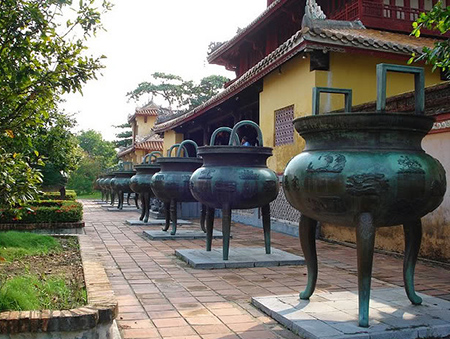
“Cuu Dinh” in Thua Thien Hue province (Photo: huefestival.com)
The set of bronze artifacts is seeking UNESCO recognition as the world’s documentary heritage under the Memory of the World Programme, the Vietnam News Agency qouted the information of the Hue Monuments Conservation Centre.
The intact urns are horizontally placed at the yard of the The To Mieu (To Mieu Temple) in the Hue Imperial Citadel, a place to worship the kings of the Nguyen Dynasty – the last feudal regime of Vietnam which ruled the country from 1802 to 1945.
All cast in bronze, they symbolise the unity and the beauty of the country as well as sustainable existence of the Nguyen Dynasty.
King Minh Mang ordered the casting of the urns in late 1835 and they were completed in early 1837.
The highest urn is 2.5 meters high versus the shortest at 2.3 meters high. Each one, weighing up to 2,600 kg, has a name symbolising a king of the Nguyen Dynasty. The central one is dedicated to King Gia Long.
The urns can also be considered a “geographic encyclopedia” of Vietnam in the 19th century with 162 carved patterns exquisitely embossed on their surface depicting popular landscapes, like rivers, mountains; and daily activities across the country, including 90 images of typical plants and animals.
These create a great combination between carving and bronze casting. Until now, all the nine urns are still in their original position and remain intact.
Comparative cultural studies in Japan, China, and the Republic of Korea showed that the set of tripod urns currently displayed in the citadel of Hue is the only existing one of its type.
It was recognised as a national treasure in 2012, and is considered the most valuable bronze works in Vietnam.
Vietnam plans to fully reopen to international visitors from June 2022
Vietnam is planning to reopen certain tourist destinations from November this year, towards a full resumption in June 2022, according to a plan mapped out by the Ministry of Culture, Sports and Tourism.
Photo for illustration (Source: hanoimoi.com.vn)
Under the draft plan that the Vietnam National Administration of Tourism (VNAT) announced at a recent meeting, domestic tourism would be resumed from November with travelers from localities where the COVID-19 pandemic is under control allowed to travel under strict pandemic preventive rules regarding vaccination, RT-PCR testing, “5K message,” health declaration, and health app use, said the Vietnam News Agency.
As for foreign visitors, Phu Quoc will re-open on a pilot basis from November this year to March 2022, followed by other destinations meeting certain requirements like Ha Long (Quang Ninh), Hoi An (Quang Nam), Nha Trang (Khanh Hoa) and Da Lat (Lam Dong) from December 2021 to June 2022.
The full opening to international visitors could be in June 2022.
On October 7, the central province of Thanh Hoa proposed to the ministry that it hopes to receive foreign tourists at the end of this year.
Meanwhile, northern cities and provinces like Hanoi, Hai Phong, Quang Ninh and Ha Giang have built various tourism products in preparation of the return of domestic visitors.
Localities that want to reopen tourism asked the VNAT to work with concerned agencies, including the Ministries of Health, Transport, Public Security and Foreign Affairs, to design consistent regulations for tourism when reopening.
Japan grants geographical indication protection for Binh Thuan dragon fruit
Binh Thuan dragon fruit was official granted the Protected Geographical Indication (PGI) certificate from the Ministry of Agriculture, Forestry and Fisheries of Japan (MAFF), on October 7, after more than 3 years of filing for geographical indication protection in Japan.
Photo for illustration (Source: danviet.vn)
This is the second agricultural product of Vietnam to receive PGI status in Japan, after Luc Ngan lychee, said the Nhan Dan Newspaper.
The PGI status of Binh Thuan dragon fruit affirms its prestige in the Japanese market, opening many new opportunities for the export and consumption of Binh Thuan dragon fruit in many different markets, especially in difficult markets such as the Europe, the Republic of Korea, and New Zealand. This also shows the role of intellectual property, which is considered a support tool for Vietnamese products to have more competitive and export advantages.
According to Dinh Huu Phi, Director of the Intellectual Property Office of Vietnam under the Ministry of Science and Technology, Japan is well known for being a "difficult" market with strict legal provisions on the protection of geographical indications.
Products granted the PGI certification in Japan are almost completely trusted by local consumers and have much higher selling prices than non-protected products in Japan.
Therefore, this is an important milestone in the process of bringing Vietnamese dragon fruit into Japan as well as paving the way for the promotion of PGI for other Vietnamese agricultural products in this market./.